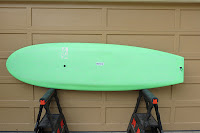Conditions had been poor all day long. But when I got to the stairs at about 2PM, lot's of regulars were gathering around, checking it and bantering about how much it sucked. But still, we waited for the tide and waited for the wind to change.
The swell(s) were a mix of NW and WNW with a horrendous short period SE wind chop on top, almost completely destroying whatever shape the incoming bigger waves were trying to deliver. Even at 2 ft. the tide seemed much fatter, it was weird. There were a handful of people out, no regulars as best as I could tell.
Finally the dropping tide got near enough to right, and the waves began to look better while everyone imagined that conditions were "improving". So folks, including myself, started paddling out.
I headed straight to my spot as I knew the crowd was going to thicken quick at the usual places in the L. Upon arrival, it was a choppy sea surface mess of a nightmare. I felt like I was doing an open ocean downwinder on a very small board, my 8 foot Original SIMSUP S3. Wave faces were bumpy and like riding the wild bronco that always wants to throw you off it's back. Take offs were in double or triple lumps, never a clean face. I was beginning to think I'd lost my marbles for being out there but...."hope springs eternal."
(I continue to be stoked beyond measure with my S3. It's never let me down no matter what kind of waves or conditions I paddle into with it. I've ridden other short so-called performance SUPs and none compare to the L41 SIMSUP. Lot's of other folks are seeing it that way too.)
It was perplexing out there because the wind was right off the Dark Hill, but the wind chop was coming from the Concrete Boat. As the tide lowered the waves became better defined and (Hallelujah!) the wind started dying down and shifting more straight offshore and the sea surface began calming down some. The wind chop bump never went away completely, but it evened out enough so that right around 3:45 things started to get fun.
Surf for the entire session was consistent and I looked forward to the occasional lull so I could catch my breath. I roamed a lot of the playing field, taking down waves from two primary take-off spots, Yellow House and Apartment House Point. The best rides averaged 200-250 yards. It didn't get crowded until about 4PM, and 75% of the surfers out were less than average ability. Around 4:15 the waves really started firing and it was becoming glassy (with much smaller and flatter wind generated bumps on top). With the two northerly swells in the water not all waves were equal with some just sectioning into impossible to make lines. But the good and lined up waves were fast and steep with smackable walls.
I was the last guy out and came in on a super fun, 240 yard zipper to end the day in almost complete darkness. Instead of paddling, I walked back on the beach made possible by the low tide. By the time I got to my car it was dark and cold. (Props to the East Coast surfers, I can only imagine your pain.) All in all the session was salvaged in the last hour and a half. Not outstanding, and not really big. Waist to shoulder high. Not the best shape and not the longest rides but finally, waves at my favorite Winter spot. I was happy with that. First time I've surfed there since January this year. I hope it's not the last.
It was perplexing out there because the wind was right off the Dark Hill, but the wind chop was coming from the Concrete Boat. As the tide lowered the waves became better defined and (Hallelujah!) the wind started dying down and shifting more straight offshore and the sea surface began calming down some. The wind chop bump never went away completely, but it evened out enough so that right around 3:45 things started to get fun.
Surf for the entire session was consistent and I looked forward to the occasional lull so I could catch my breath. I roamed a lot of the playing field, taking down waves from two primary take-off spots, Yellow House and Apartment House Point. The best rides averaged 200-250 yards. It didn't get crowded until about 4PM, and 75% of the surfers out were less than average ability. Around 4:15 the waves really started firing and it was becoming glassy (with much smaller and flatter wind generated bumps on top). With the two northerly swells in the water not all waves were equal with some just sectioning into impossible to make lines. But the good and lined up waves were fast and steep with smackable walls.
I was the last guy out and came in on a super fun, 240 yard zipper to end the day in almost complete darkness. Instead of paddling, I walked back on the beach made possible by the low tide. By the time I got to my car it was dark and cold. (Props to the East Coast surfers, I can only imagine your pain.) All in all the session was salvaged in the last hour and a half. Not outstanding, and not really big. Waist to shoulder high. Not the best shape and not the longest rides but finally, waves at my favorite Winter spot. I was happy with that. First time I've surfed there since January this year. I hope it's not the last.





